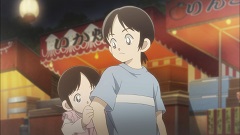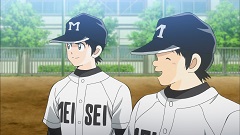Star Crossed is one of the oldest anime blogs left on the English-speaking internet, so we’re bound to have a few devotees of Mitsuru Adachi, that master of classic storytelling, among our readership. If you fall into that category, you might wonder why someone who has never read or watched Touch, his seminal work, has chosen to cover its sequel. It’s partly because my brain isn’t big enough to write about Sarazanmai on a weekly basis, but a more relevant reason is my love for Cross Game, which made me into an amateur Adachi fan after 50 all-too-brief episodes. The man’s grasp of subtle conversation, boyish humor, and slow-building romance became an addiction that, with Mix’s airing, I’m happy to revisit. I’m likely to miss references to Touch here and there, but I’ll do my best to blog this new adaptation on an episodic basis.
The one thing that I can talk about with some authority at this stage is Mix’s OP, which is brilliant. Its sense of nostalgia is aided by every element of its design, from its use of bloom lighting to the technique of aging the characters as they turn in circles, connecting their past and present selves. I particularly love the middle section, where the screen cuts between the male and female characters’ equipment and uniforms. By putting the tools of their passion front and center, it’s as if Mix intends to celebrate humanity’s dedication to art and sport. Of course, this being a baseball series, the visuals cut to pure diamond action as the accompanying song swells, and what a song it is. Kenta Kataoka’s voice has a wistful quality about it for someone so young, which makes “Equal” by Sumika a perfect pick to introduce an Adachi series. Given this OP’s fantastic storyboarding and terrific song choice, it’s already my pick for best of 2019.
As for the body of the anime, it doesn’t have the same immediate appeal. If Cross Game’s first episode was a lightning bolt to the heart, Mix’s is a lazy spring day. These second and third episodes stuck with that slow and simple feeling, but given the effectiveness of the show’s character work, I’m just fine with that. Souichiro and Touma’s competitiveness is immediately believable – instead of the one-note rivalries held by other brothers in anime, they’ve got layers of mutual respect and suppressed resentment built into their relationship already. The scene where Sou commands Touma to go home and look after their younger sister, for example, is the total package. Though Touma is the more talented baseball player of the two, and not related to Otomi by blood, he still obeys his older stepbrother and heads back to the house. When we learn about the older sibling’s desire to be a pitcher near the end of episode 3, and that Touma “made him a catcher” due to his athletic genius, Souichiro’s bid for dominance in other parts of their relationship clicks straight into place.
It’s Sou’s stepdad who shares that revealing conversation with him, in one of my favorite moments from either of these two episodes. Both he and his second wife are doting parents, if a bit silly at times. Their charming personalities (as well as their kids’ speculation about how a goofball like Eisuke landed a woman like Mayumi) help us to process their blended family situation, which would otherwise have been left entirely to the female narrator. Knowing that she’s meant to be a character from Touch keeps her from feeling entirely out of place, but I’d still prefer to learn these things via dialogue. That’s my one and only complaint about the series thus far, though. The lack of emphasis on baseball is working to the anime’s benefit so far, and there are plenty of opportunities for us to learn about characters like Otomi, as in the wordless flashback to her days as a shy summer festival attendee. There’s plenty more I could write about what the show is doing right, but I’m running out of space. Next week’s post will be dedicated entirely to the episode in question, rather than my history with Adachi or the series’ OP, so I hope to start digging a little deeper into Mix in the near future.




